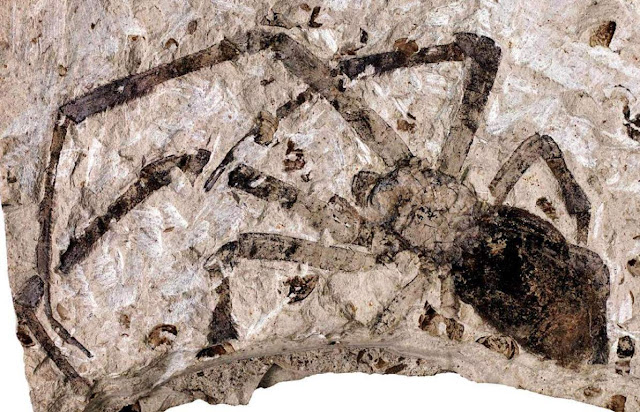
Fossil female golden orb-weaver spider (Nephila jurassica) from the Middle Jurassic of China.Credit: Paul Selden.
Prepare to be Amazed: Largest Spider Fossil Ever Discovered in China Sheds Light on Prehistoric Giants
In a groundbreaking study, led by Paul Selden from the Paleontological Institute at the University of Kansas, scientists have made an extraordinary find—the biggest known fossil spider to date. Unveiled within ancient volcanic ash, nestled in the Daohugoa fossil beds of Inner Mongolia, China, this remarkable arachnid fossil has left researchers astounded.
Measuring approximately one inch (2.5 centimeters) wide, with legs spanning up to an astonishing 2.5 inches (6.3 cm) in length, this ancient spider fossil rivals the size of its modern relatives. The current golden orb-weavers, predominantly found in tropical regions, hint at a similarly lush environment in which Nephila jurassica once thrived.

Published in the esteemed journal Biology Letters, Selden and his team reveal that this spider species inhabited a far more tropical climate than its place of discovery, indicating significant climate change in the area over time. The researchers speculate that the spider likely originated from the supercontinent Pangaea. Much like its modern counterparts, Nephila jurassica would have resided within its orb web, possibly in forest clearings or near water sources.

This groundbreaking discovery pushes back the age of the Nephila spiders far beyond previous estimations. Prior to this find, the oldest known Nephila genus fossil dated back 34 million years. However, this newly uncovered spider fossil proves that Nephila spiders have a much longer evolutionary history, challenging our understanding of their ancient origins. It is noteworthy to mention that while this fossil holds the title of the largest spider fossil ever found, it is not the oldest. Spider fossils like Eocteniza silvicola and Protoctenzia Britannica have been discovered dating back as far as 310 million years, although they do not belong to the Nephila genus.
An intriguing detail observed on the fossil spider’s legs are the visible spinnerets, the silk-spinning organs. This suggests that, similar to their modern-day orb-weaving counterparts, these ancient spiders possessed the ability to craft substantial, resilient webs capable of ensnaring a diverse array of insects. Present-day Nephila spiders, growing up to four or five inches in size, are known to spin webs robust enough to capture small birds and bats—an astonishing feat of engineering.
With each new fossil discovery, the ancient world continues to surprise and captivate us. The unearthing of this colossal spider fossil not only provides a glimpse into the prehistoric giants that roamed our planet but also deepens our understanding of the intricate web of life that has spanned millions of years. The secrets held within these ancient remains help to weave together the fascinating narrative of Earth’s diverse and ever-evolving history.